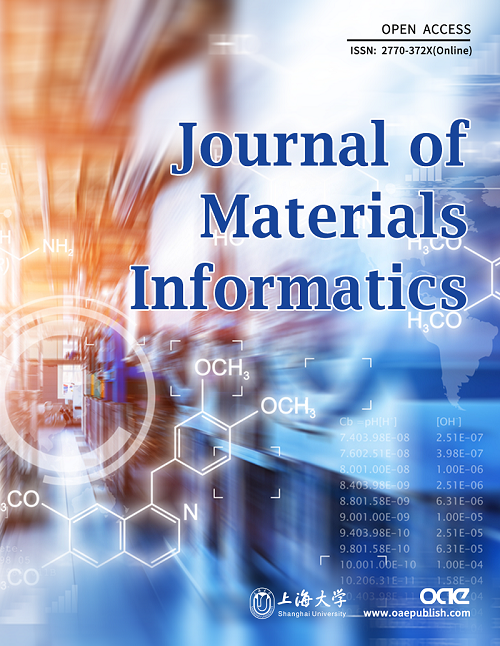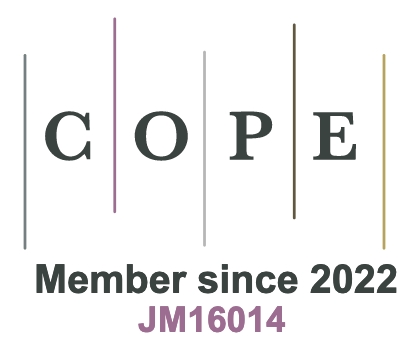REFERENCES
1. Togo A, Shinohara K, Tanaka I. Spglib: a software library for crystal symmetry search. arXiv. [Preprint.] Mar 13, 2024 [accessed on 2024 Nov 4]. Available from: https://doi.org/10.48550/arXiv.1808.01590.
2. Pidcock E, Motherwell WDS, Cole JC. A database survey of molecular and crystallographic symmetry. Acta Crystallogr B 2003;59:634-40.
3. Wondratschek H, Aroyo MI. 1.2 Crystallographic symmetry. In: International Tables for Crystallography. 2016.
4. Cao B, Yang S, Sun A, Dong Z, Zhang TY. Domain knowledge-guided interpretive machine learning: formula discovery for the oxidation behavior of ferritic-martensitic steels in supercritical water. J Mater Inf 2022;2:4.
5. Curtarolo S, Setyawan W, Wang S, et al. AFLOWLIB.ORG: a distributed materials properties repository from high-throughput ab initio calculations. Comput Mater Sci 2012;58:227-35.
6. Glass CW, Oganov AR, Hansen N. USPEX - Evolutionary crystal structure prediction. Comput Phys Commun 2006;175:713-20.
7. Wang Y, Lv J, Zhu L, Ma Y. CALYPSO: a method for crystal structure prediction. Comput Phys Commun 2012;183:2063-70.
8. Shao X, Lv J, Liu P, et al. A symmetry-orientated divide-and-conquer method for crystal structure prediction. J Chem Phys 2022;156:014105.
9. Ryan K, Lengyel J, Shatruk M. Crystal structure prediction via deep learning. J Am Chem Soc 2018;140:10158-68.
10. Zhao Y, Siriwardane EMD, Wu Z, et al. Physics guided deep learning for generative design of crystal materials with symmetry constraints. npj Comput Mater 2023;9:38.
11. Xie T, Fu X, Ganea OE, Barzilay R, Jaakkola T. Crystal diffusion variational autoencoder for periodic material generation. arXiv. [Preprint.] Mar 14, 2022 [accessed on 2024 Nov 4]. Available from: https://doi.org/10.48550/arXiv.2110.06197.
12. Batzner S, Musaelian A, Sun L, et al. E(3)-equivariant graph neural networks for data-efficient and accurate interatomic potentials. Nat Commun 2022;13:2453.
13. Zhu R, Nong W, Yamazaki S, Hippalgaonkar KH. WyCryst: Wyckoff inorganic crystal generator framework. Mater 2024;7:3469-88.
14. Chen C, Ye W, Zuo Y, Zheng C, Ong SP. Graph networks as a universal machine learning framework for molecules and crystals. Chem Mater 2019;31:3564-72.
15. Chen C, Ong SP. A universal graph deep learning interatomic potential for the periodic table. Nat Comput Sci 2022;2:718-28.
16. Merchant A, Batzner S, Schoenholz SS, Aykol M, Cheon G, Cubuk ED. Scaling deep learning for materials discovery. Nature 2023;624:80-5.
17. Sitapure N, Kwon JSI. CrystalGPT: enhancing system-to-system transferability in crystallization prediction and control using time-series-transformers. Comput Chem Eng 2023;177:108339.
18. Vriza A, Sovago I, Widdowson D, Kurlin V, Wood PA, Dyer MS. Molecular set transformer: attending to the co-crystals in the Cambridge structural database. Dig Discov 2022;1:834-50.
19. Arjovsky M, Chintala S, Bottou L. Wasserstein GAN. arXiv. [Preprint.] Dec 6, 2017 [accessed on 2024 Nov 4]. Available from: https://doi.org/10.48550/arXiv.1701.07875.
20. Goodfellow IJ, Pouget-Abadie J, Mirza M, et al. Generative adversarial networks. arXiv. [Preprint.] Jun 10, 2014 [accessed on 2024 Nov 4]. Available from: https://doi.org/10.48550/arXiv.1406.2661.
21. Gulrajani I, Ahmed F, Arjovsky M, Dumoulin V, Courville A. Improved training of Wasserstein GANs. arXiv. [Preprint.] Dec 25, 2017 [accessed on 2024 Nov 4]. Available from: https://doi.org/10.48550/arXiv.1704.00028.
22. Vaswani A, Shazeer N, Parmar N, et al. Attention is all you need. arXiv. [Preprint.] Aug 2, 2023 [accessed on 2024 Nov 4]. Available from: https://doi.org/10.48550/arXiv.1706.03762.
23. Perdew JP, Burke K, Ernzerhof M. Generalized gradient approximation made simple. Phys Rev Lett 1996;77:3865-8.
24. Togo A. First-principles Phonon Calculations with Phonopy and Phono3py. J Phys Soc Jpn 2023;92:012001.
25. Bohr N. On the constitution of atoms and molecules. 1913. Available from: https://www.nba-old.nbi.dk/pdffiles/trilogypart3.pdf. [Last accessed on 4 Nov 2024].
26. Fredericks S, Parrish K, Sayre D, Zhu Q. PyXtal: a Python library for crystal structure generation and symmetry analysis. Comput Phys Commun 2021;261:107810.
27. Steed KM, Steed JW. Packing problems: high Z’ crystal structures and their relationship to cocrystals, inclusion compounds, and polymorphism. Chem Rev 2015;115:2895-933.
28. Mouhat F, Coudert FX. Necessary and sufficient elastic stability conditions in various crystal systems. Phys Rev B 2014;90:224104.
29. Ong SP, Richards WD, Jain A, et al. Python materials genomics (pymatgen): a robust, open-source python library for materials analysis. Comput Mater Sci 2013;68:314-9.
30. Togo A, Tanaka I. First principles phonon calculations in materials science. Scr Mater 2015;108:1-5.
31. Momma K, Izumi F. VESTA: a three-dimensional visualization system for electronic and structural analysis. J Appl Crystallogr 2008;41:653-8.
32. Cao B. Whole pattern fitting of powder X-ray diffraction by expectation maximum algorithm. 2024. Available from: https://figshare.com/articles/code/Whole_Pattern_fitting_of_powder_X-ray_diffraction_by_Expectation_Maximum_algorithm/25060175?file=44225531. [Last accessed on 4 Nov 2024].
33. Hesse W, Jansen M, Schnick W. Recent results in solid state chemistry of ionic ozonides, hyperoxides, and peroxides. Prog Solid State Ch 1989;19:47-110.
34. Hayyan M, Hashim MA, AlNashef IM. Superoxide ion: generation and chemical implications. Chem Rev 2016;116:3029-85.
35. Henkelman G, Arnaldsson A, Jónsson H. A fast and robust algorithm for Bader decomposition of charge density. Comput Mater Sci 2006;36:354-60.
36. Sanville E, Kenny SD, Smith R, Henkelman G. Improved grid-based algorithm for Bader charge allocation. J Comput Chem 2007;28:899-908.
37. Cao B, Liu Y, Zheng Z, Tan R, Li J, Zhang T. SimXRD-4M: big simulated X-ray diffraction data accelerate the crystalline symmetry classification. arXiv. [Preprint.] Jun 15, 2024 [accessed on 2024 Nov 4]. Available from: https://doi.org/10.48550/arXiv.2406.15469.








